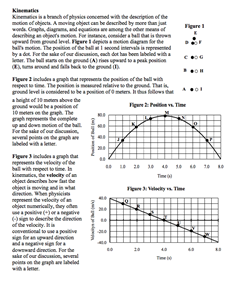 Kinematics
Kinematics
Resource:
Science Reasoning Center: Kinematics
Grade Level: High School
Description:
This passage includes a description of a ball tossed upward into the air. The description includes a dot diagram, a position-time graph, and a velocity-time graph. Questions target a student's ability to extract meaningful data from diagrams and graphs, to interpret graphs, and to make connections between the diagrams and graphs.
This activity aligns with two of the three dimensions of the Next Generation Science Standards in the manner described below:
| Patterns: Different patterns may be observed at each of the scales at which a system is studied and can provide evidence for causality in explanations of phenomena. |
As gravity affects a ball’s motion both on its way up as well as on its way back down, the reader will discover that a ball’s downward motion is just a ‘mirror image’ of its upward motion. This symmetry becomes clear in the ball’s dot diagram, the position vs. time graph, and in the velocity vs. time graph. Such patterns are not only helpful in solving kinematics problems, they speaks to gravity’s constant effect on any object in free fall. |
| Analyzing and Interpreting Data: Analyze data using tools, technologies, and/or models (e.g., computational, mathematical) in order to make valid and reliable scientific claims or determine an optimal design solution. |
With pictorial and graphical data representations of the ball’s motion, over half of the questions at the end of this passage ask the student to analyze data and make meaning of the patterns that emerge from the data sets. Like other rich data presentations, some questions require students to use information from one graph in combination with data from another to determine an unknown quantity or relationship in question. |
| Developing and Using Models: Develop and/or use a model to generate data to support explanations, analyze systems, or solve problems. |
A ball’s motion is represented in this passage using graphical and pictorial models. All questions require students to use one or more of these models to analyze the ball’s motion, to give explanations, and to solve problems. |
Associated Reading from The Physics Classroom
Other Supporting Pages at The Physics Classroom:
View Infographic.
(Coming Soon)
Search the NGSS Corner
Maybe you're looking for something really specific that pertains to a desired topic and emphasizes one or more of the listed NGSS dimensions. Why not try a search of this section of our website? Simply select from one or more of the pull-down menus and click Search. This page will reload and a collection of possibilities will be displayed in this section of the page and sorted by relevancy.